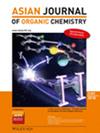Recyclable Glucose‐Derived Carbon–Silica Supported Ni(0) Nanocatalyst for Suzuki–Miyaura Cross‐Couplings
IF 2.7
4区 化学
Q1 CHEMISTRY, ORGANIC
引用次数: 0
Abstract
In this study, we report a renewable, glucose‐derived nickel(0) nanoparticles for the Suzuki–Miyaura cross‐coupling (SMC) reaction. A key feature of the catalyst is that, glucose plays the dual role which functions both as a reductant and as a carbon source for the support, enabling the formation of Ni(0) under additive‐free conditions. Further, to gain the insight of physiochemical properties, the Ni(0)NPs is characterized by PXRD, SEM, EDX, TEM, BET, XPS, ICP‐MS, and elemental mapping. The catalyst comprises metallic Ni nanoparticles (∼13 nm), uniformly dispersed on a composite support of amorphous carbon and silica. Moreover, XPS demonstrates retention of the Ni(0) oxidation state and ICP‐MS reveals no Ni‐leaching even after six catalytic cycles, indicating the system having excellent stability and indeed heterogeneity. The system performs consistently by maintaining the yields across six consecutive cycles, with favorable turnover number (TON) and turnover frequency (TOF). A CHEM21 metrics assessment is also provided to support the evaluation of reaction efficiency and operational safety.

用于Suzuki-Miyaura交叉偶联的可回收葡萄糖衍生碳-二氧化硅负载Ni(0)纳米催化剂
在这项研究中,我们报道了一种可再生的葡萄糖衍生的镍(0)纳米颗粒,用于Suzuki-Miyaura交叉偶联(SMC)反应。该催化剂的一个关键特点是,葡萄糖既充当还原剂,又充当载体的碳源,使Ni(0)在无添加剂的条件下形成。通过PXRD、SEM、EDX、TEM、BET、XPS、ICP-MS和元素映射等手段对Ni(0)NPs进行了表征,进一步了解了Ni(0)NPs的理化性质。催化剂包括金属镍纳米颗粒(~ 13 nm),均匀地分散在非晶碳和二氧化硅的复合载体上。此外,XPS显示Ni(0)氧化态的保留,ICP-MS显示即使经过6次催化循环也没有Ni浸出,表明该体系具有优异的稳定性和确实的非均质性。该系统在连续六个循环中保持了稳定的产量,具有良好的周转率(TON)和周转率(TOF)。还提供了CHEM21指标评估,以支持反应效率和操作安全性的评估。
本文章由计算机程序翻译,如有差异,请以英文原文为准。
求助全文
约1分钟内获得全文
求助全文
来源期刊

Asian Journal of Organic Chemistry
CHEMISTRY, ORGANIC-
CiteScore
4.70
自引率
3.70%
发文量
372
期刊介绍:
Organic chemistry is the fundamental science that stands at the heart of chemistry, biology, and materials science. Research in these areas is vigorous and truly international, with three major regions making almost equal contributions: America, Europe and Asia. Asia now has its own top international organic chemistry journal—the Asian Journal of Organic Chemistry (AsianJOC)
The AsianJOC is designed to be a top-ranked international research journal and publishes primary research as well as critical secondary information from authors across the world. The journal covers organic chemistry in its entirety. Authors and readers come from academia, the chemical industry, and government laboratories.
 求助内容:
求助内容: 应助结果提醒方式:
应助结果提醒方式:


